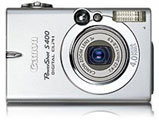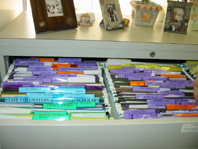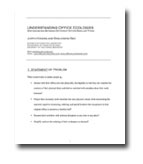| |
| |
| Projects
> Context
Aware Office |
|
|
 |
How do People Work
in their Everyday Office Spaces?
An Ethnographic Approach |
|
| |
|
|
| |
|
|
| |
Keywords:
Context Aware Computing, Context Aware Office, Office Ecologies, Digital
Ethnography,
Neat, Scruffy, Filing, Piling, Layering |
|
| |
|
|
| |
In order
to provide digital support for the diverse ways users interact with their
physical desk and other resources in their offices, we are conducting
ethnographic studies of real world office workers in their offices. Doing
so is enabling us to both develop an ontology of the rich elements populating
current offices as well as formulate an ontology of the agent’s
actions that can take place in this activity space. Because a Context
Aware Office relies on the ability to continuously model the state of
an office, we need to categorize all of the possible elements of an office
and make note of the opportunities they afford to a user.

| By investigating how office dwellers’
tasks are both reflected and shaped by their office space, we can
begin to categorize our users into different user types. This in turn
is proving helpful in designing digital supports that complement and
improve how people work. |
|
|
| |
Among the
elements in an office ontology and activity ontology are entities like:
containers (e.g. filing cabinets, binders, folders, etc.) that can contain
paper documents which support actions such as being sorted by title, relevance,
or recency; surfaces (e.g. desktops, shelves, cabinet tops, etc.) where
office elements can be placed; and content (e.g. articles, telephone numbers,
memos, etc.) which can be linked to other information or people. Based
on this sort of ontology which classifies the basic elements in an office
and their possible states, we are defining higher order attributes of
an office such as entry points. Another virtue of developing
an ontology of office elements and actions is that we can begin to explore
the sort of metadata - personal metadata - which inhabitants of offices
store about the contents of their offices. These two factors, along with
higher order ones defined in terms of them, are helping to inform the
design of Context Aware Offices. One adequacy condition on such context
aware offices is that they should be able to characterize the key elements
of an office in a sufficiently abstract and general manner that we can
determine how closely related two different physical offices are to each
other. Ideally, if there is a deep structural resemblance between two
such offices, inhabitants of one should be able to work more effectively
in the other. Indeed, in the case where we recreate by digital means the
key properties of an office, it should be possible for workers to move
from one physical office to another one and effortlessly resume their
familiar work practices at the new venue. |
|
| |
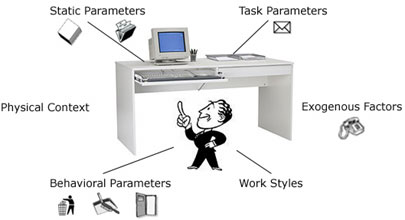
| It is important to keep in mind
that and office space is more than a desk. In order to formulate a
descriptive account of an office ecology, we need to consider the
various parameters, factors, and context of an office. |
|
|
| |
|
|
| |
What are some of the ways we can use the power of the
digital world to deal with paper in a manner that understands how people
prefer to work? Before we can propose these digital solutions to enhance
our office workspaces we need to develop a better understanding of how
people actually work in their actual office environments. We cannot expect
that a Neat person will need the same types of digital supports that a
Scruffy person will need to help organize their office. One size does
not fit all. |
|
| |
|
|
| |
|
| |
|
| Methods |
|
|
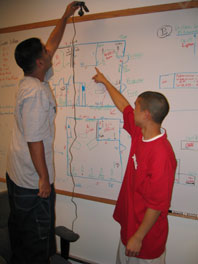 |
| Because the world of the office
dweller is complex no single method alone can accurately capture
the interaction between people and their office environments.
Each approach has its advantages and disadvantages when employed
in isolation. In order to maximize our understanding of what
takes place in offices on an everyday level we used research
methods from several different schools of thought. |
|
| How do we study
complex real world environments? |
|
|
|
| Three Types of Interviews |

| Interviews varied from
our Preliminary Office Tour to our Mid-day Interviews to our End of
the Day interviews |
|
|
|
| Two Types of
Subject Filled Logs |
|
 |
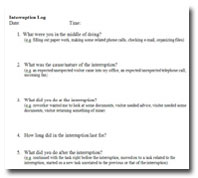 |
| Error
Logs gave us a story of what went wrong and what happened unexpectedly. |
|
| Interruption
Logs helped us determine how our subjects responded to interruptions
from the outside world. |
|
|
| |
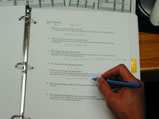 |
| With
the logs our Subjects told us a story of What happened Where,
When and also How it happened. |
|
|
|
| Subject Shot
Digital Pictures |
|
|
 |
| Our subjects took
pictures of their office surfaces and organizing structures
according to a picture checklist. |
|
| An
sample picture one of our subjects took of their office space. |
|
|
|
|
| Two Views from
our Wireless Digital Video Cameras |
|
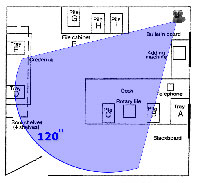 |
 |
| Wide Angle Cameras
give a nice view of the entire workspace and allow us to monitor
interruptions from the outside world. |
|
| Normal
Cameras were focused on regions where a lot of activity occurs
to give us a close up view. |
|
|
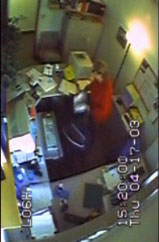 |
| Sample
View from 120 Degree Camera |
|
|
| |
|
|
| |
|
|
| |
|
|
| |
Findings |
|
| |
Our Neater dweller worked with files almost twice as much as our Scruffier
one. On the other hand, our Scruffier worker managed 50% more Piles than
our Neater one. |
|
| |
|
|
| |
|
|
| |
|
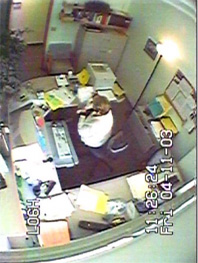 |
 |
| Our Scruffy
managed multiple layers of documents. |
|
| Our
Neat avoided layering by creating new surfaces such as
their lap. |
|
|
Layering refers to placing one pile onto another pile
with no desire to merge the two piles, thus layering different activities
onto one particular region. We found that our Scruffier person added layers
twice as often as our Neater subject did. |
|
| |
|
|
| |
|
|
| |
| Impromptu Note
Taking Devices: Sticky Notes |
|
 |
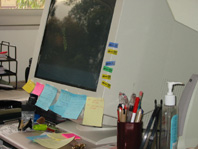 |
| Our Scruffy office
dweller made liberal use of these highly mobile note taking
devices throughout their office. |
|
Our Scruffier office dweller was a big fan of sticky
notes, but our Neater subject hated these note taking devices. Given their
strong positions on using Sticky Notes, we were not at all surprised to
see our Scruffier Office Dweller either refer to or create these impromptu
note-taking devices almost 4 times as much as our Neater Office worker. |
|
| |
|
|
| |
|
|
| |
|
 |
 |
| Our Scruffier
Office Dweller could have a more Mobile Working Space because
they needed to move and reorder information in their space to
help focus their attention on one of many open items in their
office space. |
|
One of the key attributes of sticky notes is that they
are easy to move around the office and attach to different documents or
surfaces. Information written on these impromptu note taking devices is
highly mobile and over the course of a week a sticky note can move from
a pile of papers to the monitor screen to a filing cabinet and then to
a folder on the other side of the room. Looking at how many times an office
dweller moves Piles in a day is another way of looking at whether a person’s
work frequently moves from one region of their office to another. When
a person moves a pile they are moving part of their activity to another
location in their office ecology. When we combine the number of times
our subjects used Sticky Notes with the number of times that they moved
Piles we see that our Scruffier Subject does these activities almost 2
times as much as our Neater one. Connecting this to our findings that
our Scruffier Subject handles more tasks at once, one possibility for
the more Mobile Working Space is that our Scruffy Office Dweller needed
to move and reorder information in their space to help focus their attention
on one of many open items in their office space. |
|
| |
|
|
| |
|
|
| |
Current and Future Studies |
|
| |
- Employing the Participant/ Observer method to acquire a deeper understanding
of our subject's job function.
- Controlling for differences in jobs and tasks
- Reviewing Videos with Subjects to gain a better understanding of what
is occurring in their offices.
- Increasing Sample Size.
- Tracking the life history of documents
- Studying people's emotional investments in their office spaces
- Considering how the physical world is coordinated with the digital
world.
|
|
| |
|
|
| |
|
|
| |
Project Team |
|
| |
|
| |
|
| |
|
| |
|
| |
|
|
| |
Related Work |
|
| |
Kirsh, David. The
Context of Work. Human Computer Interaction. 2001.
Malone, Thomas W. How
Do People Organize their Office Spaces: Implications for the Design of
Office Information Systems. 1983. |
|
| |
|
|
| |
|
|
 |








